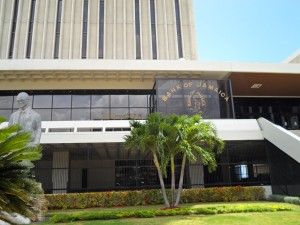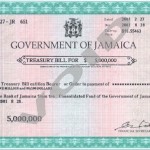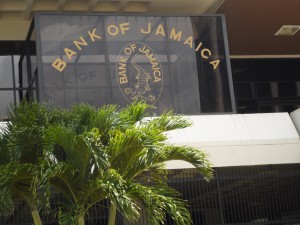 Jamaica has to rely on the private sector, to help lift it from the economic quagmire it finds itself in, for the past 3 decades. A look at certain data shed some light on the task the country faces.
Jamaica has to rely on the private sector, to help lift it from the economic quagmire it finds itself in, for the past 3 decades. A look at certain data shed some light on the task the country faces.
It tells of a nation where the business sector leaders seem to be managing more from the seat of their pants than based on properly informed position. Take the case of inflation, which ran at 5.1 percent up to August, for 2014, for an average of just less than 0.68 percent per month, and against the back ground of slippage in the exchange rate in the early months that would have helped spike inflation then. With an almost stable Jamaican dollar in September a survey done by the Statistical Institute of Jamaica on behalf of the Bank of Jamaica to ascertain the expectations of Chief Executive Officers, Managing Directors and Financial Controllers about the future movement of prices in September this year, to which 270 responded, found that their expectation for inflation for 2014, will end at 10.2 percent. On what basis is they arrive at this forecasted amount.
Interestingly, the official inflation rate to October is 7.3 percent, the full year’s figure should hoover around this level with the price of oil on the world market having declined sharply, pulling some local cost down with it.
The business sector record on business confidence both on the current state as well as a year out has no better record as ca be seen from the wild fluctuation in the periodic results.
On the matter of Treasury bill rate, while rates have been declining monthly from a peak in March, this year. The survey respondents expected the rate for the 182 day Treasury bill to come out at 8.6 percent at a time the rate had already declined to 8 percent. Admittedly, the interest rate forecast is not totally inconsistent with the managerial group inflation forecast, as investors would want to be compensated with an interest rates above the inflation as they see it. But if the inflation rate forecasted is as high as the private sector figures there would also be need for a greater slippage in the rate of exchange for the Jamaican dollar versus the US dollar. Yet their perception that the exchange rate would slip by 1.3 percent by the end of 2014 from September, would not be in keeping with the high inflation rate they projected.
Business sector don’t get it
Future business confidence jumps 19%
A recent survey, undertaken on behalf of Bank of Jamaica by The Statistical institute of Jamaica, shows continued improvement in the perception of present and future business conditions among respondents within the executive ranks of corporate Jamaica.
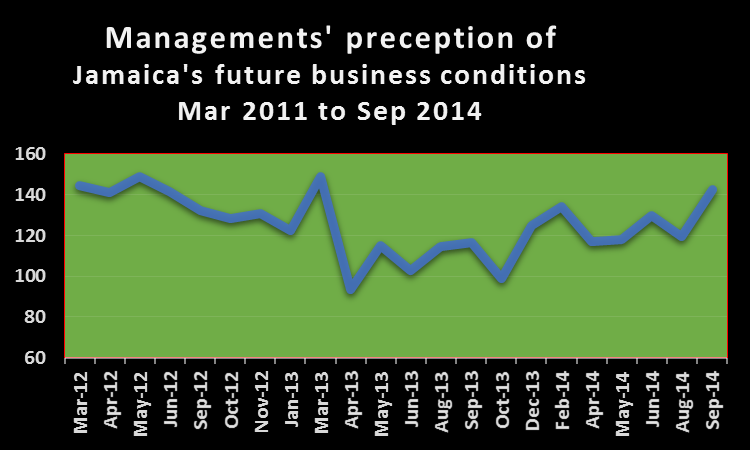 The improvement in current conditions show, a gradual monthly improvement since April last year, with periods of slippages in between. The September result of 123.6 reflects a recovery from a fall in August this year to 110.2. It is now just a little higher than the level reached in July of 121.1 and is at its highest since March last year, when the survey showed a 134.7 reading. If the business sector is gaining increasing confidence about current conditions they seem pretty bullish about the future a year out, as the perceptions of future business conditions continue to display a general upward trend, with the latest numbers coming in at 142.4 representing a leap of 19 percent from August this year. The latest survey figures for future conditions, is a shade short of the 148.8 achieved in May 2012 and March 2013.
The improvement in current conditions show, a gradual monthly improvement since April last year, with periods of slippages in between. The September result of 123.6 reflects a recovery from a fall in August this year to 110.2. It is now just a little higher than the level reached in July of 121.1 and is at its highest since March last year, when the survey showed a 134.7 reading. If the business sector is gaining increasing confidence about current conditions they seem pretty bullish about the future a year out, as the perceptions of future business conditions continue to display a general upward trend, with the latest numbers coming in at 142.4 representing a leap of 19 percent from August this year. The latest survey figures for future conditions, is a shade short of the 148.8 achieved in May 2012 and March 2013.
 The data for both surveys show the difficulty in relying on them as to what can really be expected going forward, with fairly high levels of variations. This is also borne out by the forecasting of the business sector on inflation, with their forecast consistently ahead of what the out turns end up being.
The data for both surveys show the difficulty in relying on them as to what can really be expected going forward, with fairly high levels of variations. This is also borne out by the forecasting of the business sector on inflation, with their forecast consistently ahead of what the out turns end up being.
Scotiabank Canada to cut 1,500 jobs
 Scotiabank Canada is to cut 1,500 positions worldwide and take a profit hit in fourth quarter of its 2014 fiscal year, ending in October. About two thirds of the cut will come from its Canadian operation and according to Yahoo.com will result in a charge of $340 million against 2014 profit.
Scotiabank Canada is to cut 1,500 positions worldwide and take a profit hit in fourth quarter of its 2014 fiscal year, ending in October. About two thirds of the cut will come from its Canadian operation and according to Yahoo.com will result in a charge of $340 million against 2014 profit.
Despite the charge, profit outlook remain good for 2014 and beyond, but the move is as a result of general weakness of Caribbean economies, sporadic use of branches, weekly and bi-weekly, instead of consistent daily use. The sporadic branch use will result in branch closures, mainly in Caribbean and Mexico. The bank’s foot print in Mexico are many, BNS management said, but the branches to be shuttered lack traffic, which means the bulk of the branch closure will occur in this country. The bank says they will be moving to use more ATMs and internet banking facilities, in place of the physical branches.
The BNS has written down its investment in the economically challenged Venezuela, reducing it to only $50 million.
What is known is that the Caribbean region has suffered considerably from the economic downturn experienced since 2008. The operations in Jamaica has seen profit stagnated in Jamaican dollars and slipped in Canadian dollars as the Jamaican dollar was devalued. Profits stagnated in Trinidad banking subsidiary, as well. Loan demand has not been robust within the region either, and the absence of a meaningful pick up in this critical area will result in a drag on profit growth, as long as that remains the case. The sharp fall in the price of oil is going to place pressure on the twin island state of Trinidad and Tobago and by extension some of the other territories that may be dependent somewhat on business out of Trinidad. This latest development could be negative for Scotia’s Trinidad operation. Compounding the problem for Scotia, is that Jamaica that has started enjoying moderate growth that could lead to increased private sector loan demand, is faced with lower demand for government funding, as the government moves from deficit financing to one of surplus.
Is employment really up?
 The employment numbers rose 16,700 (1.5 percent) to reach 1,124,600 persons, in June this year compared to the same time in 2013, according to data just released by Statistical Institute of Jamaica (Statin), but is down from March this year, with the data showing 1,133,000 persons employed at that time, and the unemployment rate at 13.6 percent.
The employment numbers rose 16,700 (1.5 percent) to reach 1,124,600 persons, in June this year compared to the same time in 2013, according to data just released by Statistical Institute of Jamaica (Statin), but is down from March this year, with the data showing 1,133,000 persons employed at that time, and the unemployment rate at 13.6 percent.
“The Employed Labour Force this year June, is more than the 1,107,900 recorded in June 2013”, Statin said.
The latest data brought the Employment Rate for June 2014, to 86.2 percent of the work force, a 1.6 percentage point increase, compared with 84.6 percent in June 2013. The Employment Rate increased for males, by 1.8 percentage points, moving from 88.3 percent to 90.1 percent, and for females it increased by 1.5 percentage points, from 80.1 percent to 81.6 percent.
The unemployment rate stood at 13.8 percent at mid 2014 compared to 15.4 percent at the same time in 2013. Overall the number of unemployed persons decreased by 22,200 (11.0 percent) moving from 201,600 persons in July 2013 to 179,400 persons in July 2014, the report stated. But the number of persons who were classified as Outside the Labour Force in June 2014 was 778,300, an increase of 10,400.
There are seasonality in the data for employments making it a bit difficult to compared successive quarter with each other. It is expected that the Christmas quarter with increase business activity and the first quarter of the year with increased tourists arrivals and sugar production tends to have more persons employed than for the other periods of the year.
Who got jobs?| “There were significant increases in employment in the Occupation group ‘Professionals, Senior Officials and Technicians’ which increased by 14,000 persons (5.9 percent), moving from 239,400 in July 2013 to 253,400 in July 2014. Increases in employment were also observed in the group, ‘Elementary Occupations’, which increased from 142,100 persons in July 2013 to 147,900 persons (4.1 percent) in July 2014. The group ‘Craft and Related Trades Workers’ had the largest decline for the period, moving from 141,800 in July 2013 to 136,300 in July 2014 resulting in a decline of 5,500 (3.9 percent) persons,” Statin stated.
Statin went on to say that “the largest increase in the number of employed persons, were for persons in the group ‘Hotels & Restaurants Services’ that increased by 7,800 (10.4 percent) persons while ‘Education’ increased by 5,000 (7.4 percent) persons. The group ‘Real Estate, Renting &
Business Activities’ declined from 69,900 in July 2013 to 64,400 in July 2014 resulting in a decline of 5,500 (7.9 percent) persons.
PAYE gains can’t cover corporate shortfall
 PAYE collections, outperformed forecast for September, by $620 million and $677 million, for the six months to September, this year, but that was inadequate to cover the $2.5 billion drop in corporate taxes, in the latest month, for government of Jamaica revenues.
PAYE collections, outperformed forecast for September, by $620 million and $677 million, for the six months to September, this year, but that was inadequate to cover the $2.5 billion drop in corporate taxes, in the latest month, for government of Jamaica revenues.
At the end of August, corporations paid over $6.63 billion versus a projection for $8.8 billion, resulting in a shortfall of $2.18 billion, by the end of September, what should have been collections of $15.3 billion turned up to be only $10.65 billion, $4.7 billion short, resulting in a $2.5 billion shortfall, in the latest month alone. The underperformance for company tax collection, was the main reason why the revenue forecast of $156.5 billion for the six months period, suffered an increased shortage of $1.4 billion in tax revenues, bringing the year to date shortfall, to $7.33 billion. Overall revenue shortage, amounted to $7.13 billion, as grants fell short by $337 million in September, but non tax revenues outperformed forecast, by $400 million for the month.
Expenditure| Payment for expenses is well below target, as capital expenditure almost crawled to a halt in September, with only $590 million spent, raising the underspending for the year to date to $7.8 billion, up from $5.38 billion at the end of August. Programmes saw savings in payments of nearly $900 million, in the month, and wages and salaries was $350 million more, in the month, than planned, but there is still a reduction year to date, in this area.
At the end of September, the fiscal deficit of $18.95 billion was ahead of target by $6.3 billion, as the capital programmes have once more taken the bulk of the hit, as revenues fall short of target.
Low forex demand forced BOJ’s intervention
IC Insider can now confirm that the country’s central bank (Bank of Jamaica) has been intervening in the market to purchase excess funds and thus prevent too much appreciation for the Jamaican dollar at a time when the rate of inflation has been rising and could erode the gains made against the US dollar, in 2014.
Authorized dealers purchased the equivalent of US$32,649,087 versus US$32,884,034, on Wednesday and sold the equivalent of US$28,021,523 compared with US$32,831,045 on Wednesday.
 In US dollar trading, dealers bought US$25,714,484 compared to US$30,229,144 on Wednesday. The buying rate for the US dollar lost 3 cents to $112.32 and US$24,894,405 was sold versus US$31,632,195 on Wednesday, the selling rate rose 3 cent to $112.76. The Canadian dollar buying rate, rose $2.38 to $100.66 with dealers buying C$3,327,907 and selling C$1,986,255, at an average selling rate that climbed $1.37, to $101.98. The rate for buying the British Pound moved down 85 cents to $178.10, for the purchase of £943,417, while £400,984 was sold, at $180.46, a fall of $1.02. Other currencies bought, amounted to the equivalent of US$2,456,217, while the equivalent of US$689,010, was sold.
In US dollar trading, dealers bought US$25,714,484 compared to US$30,229,144 on Wednesday. The buying rate for the US dollar lost 3 cents to $112.32 and US$24,894,405 was sold versus US$31,632,195 on Wednesday, the selling rate rose 3 cent to $112.76. The Canadian dollar buying rate, rose $2.38 to $100.66 with dealers buying C$3,327,907 and selling C$1,986,255, at an average selling rate that climbed $1.37, to $101.98. The rate for buying the British Pound moved down 85 cents to $178.10, for the purchase of £943,417, while £400,984 was sold, at $180.46, a fall of $1.02. Other currencies bought, amounted to the equivalent of US$2,456,217, while the equivalent of US$689,010, was sold.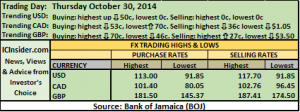 Highs & Lows| The highest buying rate for the US dollar, fell 50 cents to $113, the lowest buying, the highest selling and the lowest selling rates were unchanged at $91.85, $117.70 and $91.85 respectively. The highest buying rate for the Canadian dollar fell 53 cents to $101.40, the lowest buying rate rose 70 cents to $80.05, the highest selling rate fell 36 cents to $102.76. The lowest selling rate declined $1.05 to $96.45. The highest buying rate for the British Pound, dipped 70 cents to $181.50. The lowest buying rate eased 46 cents to $145.37, the highest selling rate rose 27 cents to $187.41 and the lowest selling rate dropped $3.50 to $174.50.
Highs & Lows| The highest buying rate for the US dollar, fell 50 cents to $113, the lowest buying, the highest selling and the lowest selling rates were unchanged at $91.85, $117.70 and $91.85 respectively. The highest buying rate for the Canadian dollar fell 53 cents to $101.40, the lowest buying rate rose 70 cents to $80.05, the highest selling rate fell 36 cents to $102.76. The lowest selling rate declined $1.05 to $96.45. The highest buying rate for the British Pound, dipped 70 cents to $181.50. The lowest buying rate eased 46 cents to $145.37, the highest selling rate rose 27 cents to $187.41 and the lowest selling rate dropped $3.50 to $174.50.
Berger surges to the top
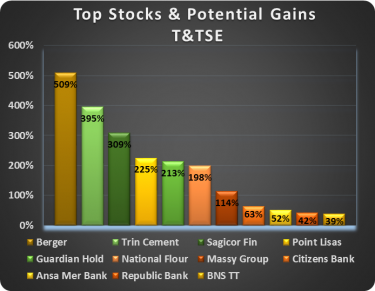 Berger Paints surged to the top of the list of stocks on the Trinidad & Tobago Stock Exchange that should return the highest gains to investors, in the months ahead, with the potential to reach 500 percent.
Berger Paints surged to the top of the list of stocks on the Trinidad & Tobago Stock Exchange that should return the highest gains to investors, in the months ahead, with the potential to reach 500 percent.
Next in line is Trinidad Cement with 300 percent. Scotiabank has fallen to $58 from a high of $73.12 earlier this year. At the close of trading for the week, Scotiabank’s price seems set to decline further, with selling pressure still overwhelming buying interest, at the current price level. The decline so far has put the stock back in the list of top buys, with potential gain of 40 percent at the last traded price. The bank reported poor results in the first half of the fiscal year, but showed strong gains in the July quarter including good pick up in loans. This suggest that 2015 earnings should move up attractively, subject to continued growth in the loan portfolio. Importantly the PE has fallen in line with Republic Bank at around 16 times earnings and only slightly above the rest. Berger has surged based on the latest results, putting profit for the six months to September at $1.122 million, a big improvement over than the $240,000 earned in the 2013 period and almost ensuring that the full year’s earnings of $2.93 million to March this year, will be bettered by a good degree. 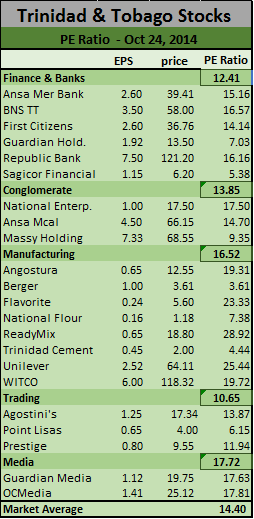 Berger’s profit improvement is flowing from reduced cost rather than sales growth. Sales fell slightly to $29.8 million for the half year, compared to $30.1 million in the 2013 period. IC Insider is forecasting $1.10 per share, around $6 million after tax for the current year.
Berger’s profit improvement is flowing from reduced cost rather than sales growth. Sales fell slightly to $29.8 million for the half year, compared to $30.1 million in the 2013 period. IC Insider is forecasting $1.10 per share, around $6 million after tax for the current year.
Rounding out the top list of the stocks that virtually select themselves are, Sagicor Financial, Point Lisas, Guardian Holdings, National Flour Mills, Massy Holdings, First Citizens Bank, Ansa Merchant Bank, Republic Bank and Scotiabank.
The 2014 financial year for a number of the companies have ended in September, with more results to be released soon. Investors’ minds will start to focus on 2015 when the results for some of the companies will show improvement over 2014, making the stocks cheaper now than they are likely to be a few months from now when the results for 2015 starts to flow.
Trinidad Cement released their nine months results to September which point to earnings from continuing operations being 13 cents for the quarter and annualised at 52 cents per share. The agreement to supply Venezuela with 240,000 tonnes of clinker will help boost the group’s profit, while the contract is being satisfied. While debt is a negative, the present cash flow if continued, will see them out of danger within 3-4 years.
Overall the TTSE market average PE is at 14.4 with 12 stocks above this levels and 10 stocks below.
Treasury-bill rates fall again
The Treasury bill for the period Friday, October 24 to mature on Friday, January 23 next year, attracted an average yield of 7.336 percent, down from 7.46952 percent, at the September auction. At the August auction the average rate out turn was 7.46767 percent. The yield for July was an average of 7.63643 percent, for the June issue 7.65893 percent and 8.2 percent in May, for the Treasury bill of same duration.
The offer of 182 days duration, maturing on April 24 next year, generates an average interest rate yield of 7.73187 percent, a decline from 7.99887 percent, at the September auction, 8.11578 percent, in August, 8.21982 percent at the July’s auction and 8.36502 percent for the June issue, of the same duration. At the May Treasury bill auction, the rate came out at 8.932 percent.
BNS & NCB in grand US$ sell off on Friday
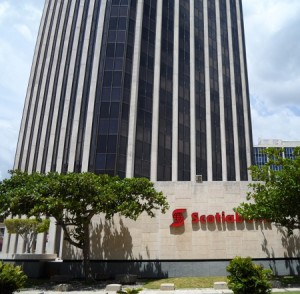 Authorized Dealers sold much more foreign currency that they bought on Friday. Bank of Nova Scotia (BNS) and National Commercial Bank (NCB) were big net sellers of the US dollar, the second consecutive day of a big net sell off by dealers. BNS was the largest net seller, with US$4.58 million bought to US$15.26 million sold, followed by NCB buying US$4.13 million and selling US$12.6 million. On Thursday BNS bought US$7.33 million and sold US$14.23 million while National Commercial Bank, was buying US$2.67 million and selling US$5.54 million.
Authorized Dealers sold much more foreign currency that they bought on Friday. Bank of Nova Scotia (BNS) and National Commercial Bank (NCB) were big net sellers of the US dollar, the second consecutive day of a big net sell off by dealers. BNS was the largest net seller, with US$4.58 million bought to US$15.26 million sold, followed by NCB buying US$4.13 million and selling US$12.6 million. On Thursday BNS bought US$7.33 million and sold US$14.23 million while National Commercial Bank, was buying US$2.67 million and selling US$5.54 million.
The Jamaican dollar slipped slightly against the US dollar, but appreciated against the Pound and the Canadian dollar, in Friday’s forex trading. Authorized dealers purchased the equivalent of US$49,065,272 versus US$27,673,332 on Thursday. The equivalent of US$60,366,852 was sold, compared with US$42,183,198 on Thursday.
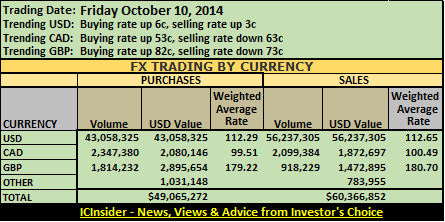 In US dollar trading, dealers bought US$43,058,325 compared to US$25,657,012 on Thursday. The buying rate for the US dollar was up 6 cents to $112.29 and US$56,237,305 was sold versus US$40,190,794 on Thursday, the selling rate rose 3 cents to $112.65. The Canadian dollar buying rate, climbed 53 cents to $99.51 with dealers buying C$2,347,380 and selling C$2,099,384 at an average selling rate that declined 63 cents, to $100.49. The rate for buying the British Pound is up by 82 cents to $179.22, for the purchase of £1,814,232, while £918,229 was sold, at $180.70, down 73 cents. Other currencies bought, amounted to the equivalent of US$1,031,148, while selling was for the equivalent of US$783,955.
In US dollar trading, dealers bought US$43,058,325 compared to US$25,657,012 on Thursday. The buying rate for the US dollar was up 6 cents to $112.29 and US$56,237,305 was sold versus US$40,190,794 on Thursday, the selling rate rose 3 cents to $112.65. The Canadian dollar buying rate, climbed 53 cents to $99.51 with dealers buying C$2,347,380 and selling C$2,099,384 at an average selling rate that declined 63 cents, to $100.49. The rate for buying the British Pound is up by 82 cents to $179.22, for the purchase of £1,814,232, while £918,229 was sold, at $180.70, down 73 cents. Other currencies bought, amounted to the equivalent of US$1,031,148, while selling was for the equivalent of US$783,955.
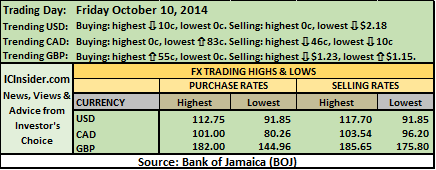 Highs & Lows| The highest buying rate for the US dollar, closed 10 cents lower, at $112.75, the lowest buying and the highest selling rates, were unchanged at $91.85 and $117.70 respectively, the lowest selling rate dropped $2.18 to $91.85. The highest buying rate for the Canadian dollar remained at $101, the lowest buying rate rose 83 cents to $80.26, the highest selling rate fell 46 cents to $103.54. The lowest selling rate closed down 10 cents to $96.20. The highest buying rate for the British Pound, increased by 55 cents to $182, the lowest buying rate was unchanged at $144.96. The highest selling rate, dropped $1.23 to $185.65 and the lowest selling rate rose $1.15 to $175.80.
Highs & Lows| The highest buying rate for the US dollar, closed 10 cents lower, at $112.75, the lowest buying and the highest selling rates, were unchanged at $91.85 and $117.70 respectively, the lowest selling rate dropped $2.18 to $91.85. The highest buying rate for the Canadian dollar remained at $101, the lowest buying rate rose 83 cents to $80.26, the highest selling rate fell 46 cents to $103.54. The lowest selling rate closed down 10 cents to $96.20. The highest buying rate for the British Pound, increased by 55 cents to $182, the lowest buying rate was unchanged at $144.96. The highest selling rate, dropped $1.23 to $185.65 and the lowest selling rate rose $1.15 to $175.80.
Jamaica’s remittance inflows grow
 Remittance inflows into Jamaica, this year, continue to grow, with an increase of US$50 million or 5.6 percent in net remittances for the six months to June, over the same period in 2013, to reach US$949 million, according to information released by the country’s central bank.
Remittance inflows into Jamaica, this year, continue to grow, with an increase of US$50 million or 5.6 percent in net remittances for the six months to June, over the same period in 2013, to reach US$949 million, according to information released by the country’s central bank.
“Total remittance inflows were US$1.06 billion, an increase of US$35 million while outflows declined compared with the 2013 period,” the Bank of Jamaica report states. Net remittances for June 2014, were US$154 million, an increase of US$8 million or 5.4 percent over the corresponding period of 2013, resulting from an increase in gross remittance inflows and a contraction in outflows. Gross remittance inflows for the month were US$168 million, an increase of US$2.3 million or just 1.4 percent relative to the corresponding month of 2013.
For June, total Remittance Outflows amounted to $15 million a reduction from the $20 million in June 2013 and for the six months, $106 million and $121 million in 2013.
- « Previous Page
- 1
- …
- 510
- 511
- 512
- 513
- 514
- …
- 516
- Next Page »
